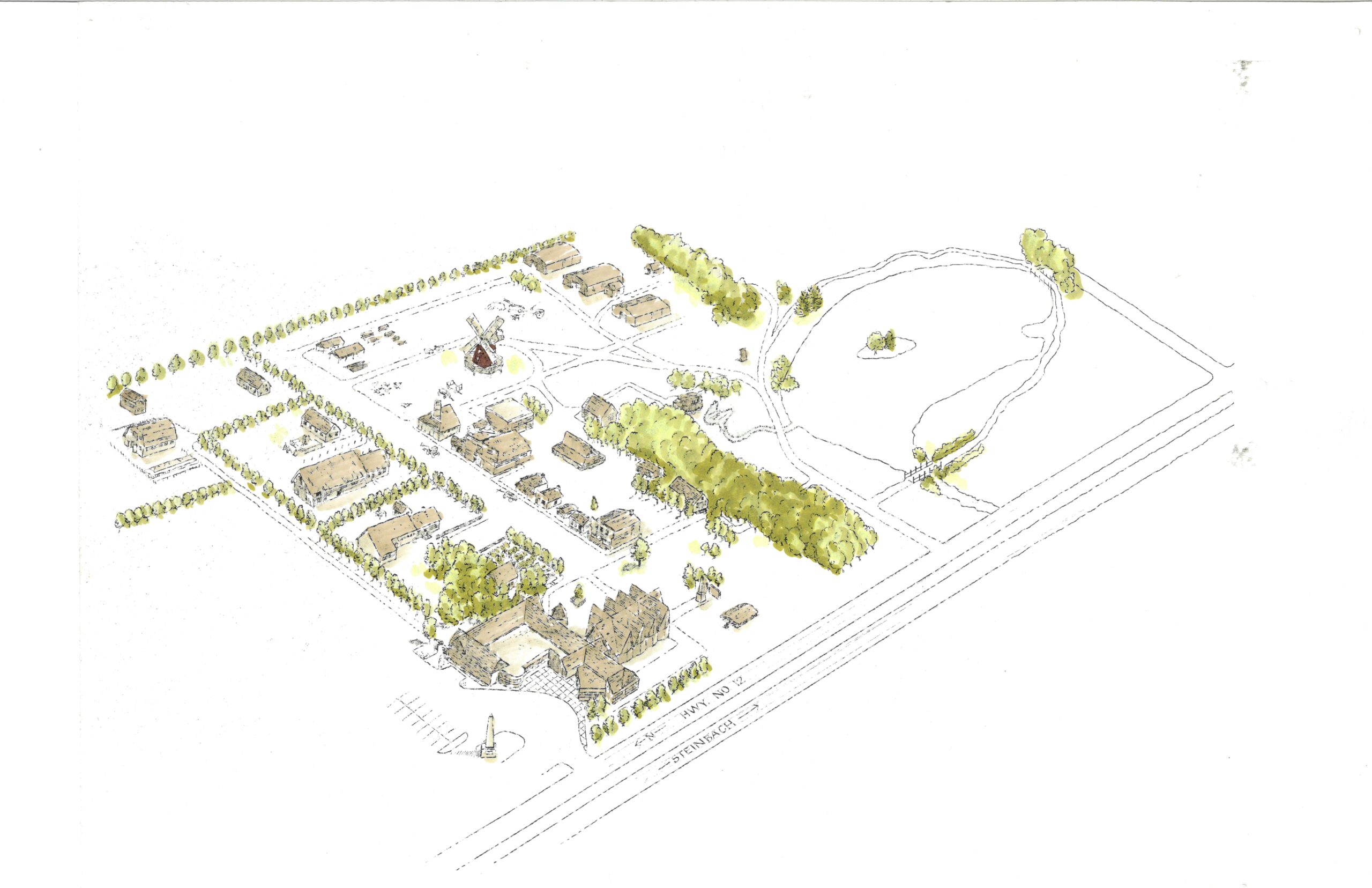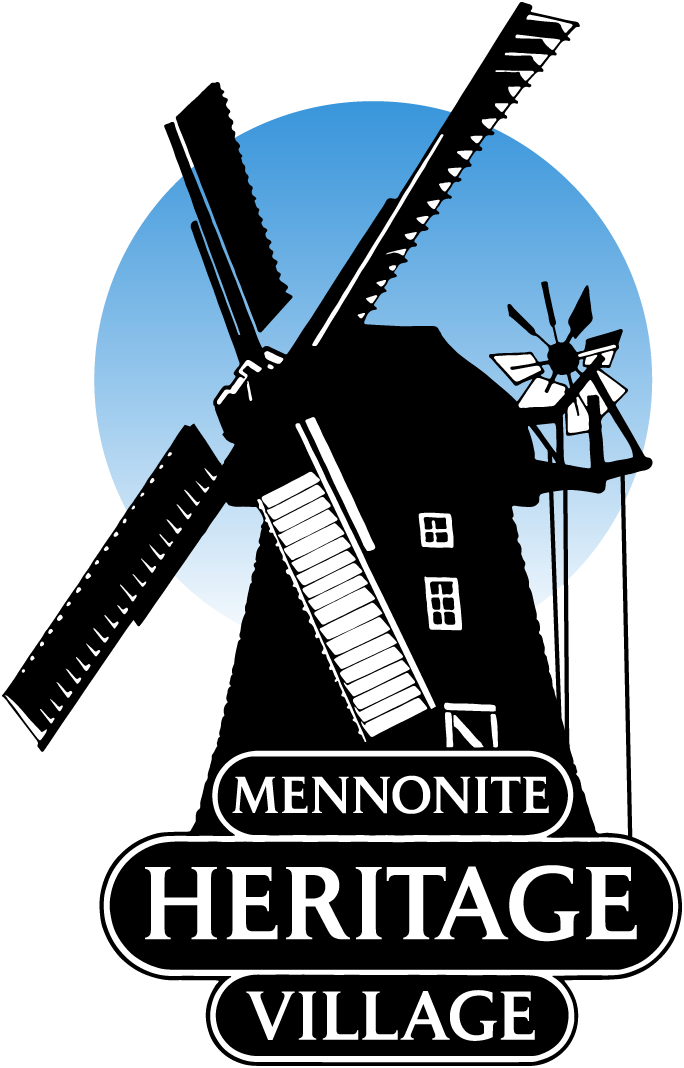The Village

Toilets
Toilets
Toilets
Village Centre
The Village Centre houses the museum’s galleries telling the Russian Mennonite story from the 1500s to the present. The Gerhard Ens Gallery and the auditorium present temporary exhibits. Our gift shop offers a variety of books and souvenirs.
Semlin
Sod and wood were the materials of the first homes built by Mennonite immigrants in 1874. Although crude, these buildings provided shelter for survival on the Manitoba prairies.
Johann Bartsch Memorial
Honouring Johann Bartsch, one of two Mennonite delegates to Russia in 1786, the monument was originally erected in Rosenthal, New Russia (today Ukraine), in 1890.
Chortitza Oak
This tree was grown from an acorn of the 700-year-old oak tree, a landmark of the Chortitza Mennonite Colony in New Russia.
Monument to Mennonite Women
Women were involved in all areas of life in Mennonite settlements in Manitoba – from child-rearing and education to hauling lumber for construction and dealing with farmyard emergencies. This monument honours their contributions and was commissioned by the MHV Auxiliary in 1985.
Hochfeld House
With oak logs and larger rooms, the log house was a vast improvement over the Semlin. This early dwelling was built in the Mennonite village of Hochfeld, Manitoba, in 1877.
Orchard
Mennonite families planted wild Manitoba fruit trees and bushes in their orchards. The harvested and preserved fruit provided important nutrients during the winter.
Chortitz Housebarn
The Mennonite practice of joining house and barn under one roof can be traced to their settlement in Prussia/Poland from the 1500s onwards. This home was constructed in 1892 in Chortitz, south of Winkler, Manitoba.
Vegetable Garden and Summer Kitchen
During hot summers, family meals were prepared in the summer kitchen so the large house would remain cool. Vegetable gardens were important in Mennonite communities, as the settlers grew much of their own food, but also as social spaces to visit with friends and family.
Outdoor Oven
Hearty breads and buns, a Mennonite staple, are baked in the traditional clay oven using flax straw.
Waldheim House
This oak log building was built in 1876 in the village of Waldheim, near Morden, Manitoba. It is the oldest building at the museum and was the first one moved to this site. The thatched roof was added to the building in 2017.
The Peters Barn
This barn was built in 1885 in Vollwerk, just south of Mitchell, Manitoba. The farm site was originally settled by Jakob Peters (1813-1884), one of the delegates from the Bergthal Colony in Russia seeking new settlement opportunities in North America in 1873. The barn was moved to this site and joined to the Waldheim House in 2006.
Jacob Hoeppner Memorial
Originally erected on the island of Chortitza, New Russia, this memorial honours one of the Prussian Mennonite delegates who toured Russia in 1786-1787, prior to Mennonite settlement.
Old Colony Worship House
Usually situated in the centre of the village, this plain building symbolized the centrality of religious life in Mennonite villages. Community members provided logs in 1881 to build this worship house in Chortitz, south of Winkler, Manitoba.
Blumenhof Mennonite School
Most Mennonite schools before 1910 had the same basic plan of classroom and teacherage under one roof. This school was built in the village of Blumenhof, near Altona, in 1885.
Barn and Animal Pens
Animals are kept here during the summer months to illustrate the mixed farms of Mennonite settlers. Youngsters enjoy this feature of the museum!
Granary
This granary was built in 1892 by Abraham S. Friesen, owner of Steinbach’s first windmill, and featured a cleaning mill in the upper floor.
Sawmill
Timbers and boards for the villages’ first homes were cut by hand in a saw pit. The arrival of steam engines made this work much easier and more efficient. This sawmill was used by conscientious objectors in Riding Mountain National Park during the Second World War.
Windmill
Mennonites used windmills to grind grains and drain marshes throughout their history in Europe. The first windmill in Steinbach was built in 1877. A replica was built at the museum in 1972 but destroyed by fire in 2000. The current windmill was rebuilt in 2001.
Barkfield Public School
Built in 1919 just south of Steinbach, this building is typical of one-room schools in southern Manitoba in the 1920s. It represents the change from private Mennonite education to the public school system.
Steamer Shelter
This structure was built for the museum’s 1904 Reeves steamer and is used for a variety of functions throughout the summer.
Livery Barn Restaurant
Reminiscent of the livery barns, or horse stables, that were rest stops for prairie settlers, the museum restaurant offers refreshments and traditional Mennonite food.
Blacksmith Shop
An important source for tools and repairs for the early settlers, who required constant maintenance of their farm implements.
Printery
This print shop features the original printing equipment, used by Jacob S. Friesen, who published local newspapers, including Die Steinbach Post, from 1909 to 1924.
Reimer Store
Klaas Reimer’s general store was the first in the village of Steinbach in 1884. This building also acted as Steinbach’s first museum, started by Klaas’s grandson, John C. Reimer, whose collection of artefacts eventually became the foundation for establishing Mennonite Heritage Village in 1964.
General Store
Try some old-fashioned stick candy and browse through a wide variety of local handicrafts and toys.
Lichtenau Church
This church was built in 1930 by “Russländer” Mennonites, who immigrated from Russia in the 1920s. It was formerly situated at Ste. Elizabeth and is the first church in Manitoba built by Mennonites from this migration
Short Order Booth
During our special events, you will find tasty festival food here. The menu includes our famous waffles with vanilla sauce, rollkuchen and watermelon, as well as burgers, hot dogs, french fries, and soft drinks.
Agricultural Display Building
Discover our collection of antique tractors, many owned and maintained by members of the Southeast Implement Collectors Club.
Transportation Building
Steinbach played a significant role in the early growth of Canada’s trucking and automobile industry. This building features antique trucks, cars, and fire engines.
Berlin Wall
From August 13, 1961, to November 9, 1989, a barrier of concrete, barbed wire, and armed sentries separated the people of East and West Berlin, characterizing the Cold War. This tragic separation of families and repression of freedom was also experience by Mennonite people after the Second World War.
Monument to Victims of Violence and Terror
In commemoration of the victims of violence in the 20th century.
Pond Trail
Hike the trail encircling the pond and explore its many unique vantage points, including a wrought iron bridge.
Peter Barkman Pavilion
The pavilion, opened in 2017, is a great venue for corporate picnics, family gatherings, weddings, and more. It also provides extra, sheltered restaurant seating.
Conscientious Objectors Cairn
The monument is a symbol of Mennonite pacificsm and commemorates conscientious objectors who served Canada during the Second World War as an alternative to joining the armed forces. Mennonites have a heritage of faithful non-violence which is one of the factors that led them to Canada.
Reimer Gravestone
Erected in 1892 in the village of Wiesenfeld, New Russia, this stone commemorates the life of Jacob D. Reimer, one of the founders of the Mennonite Brethren Church.
Dirk Willems Peace Garden
A beautiful setting to contemplate Dirk Willem’s challenging example of compassion for his enemies and the Mennonite history of pacifism in a violent world.
